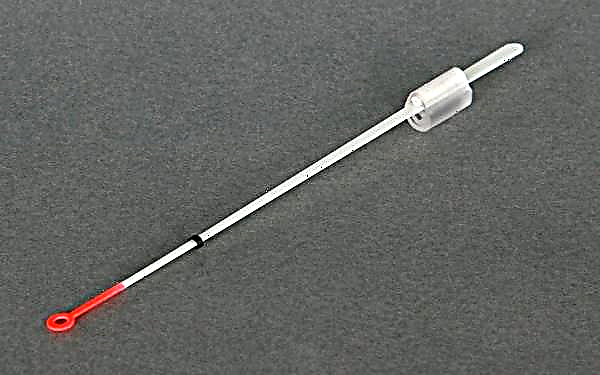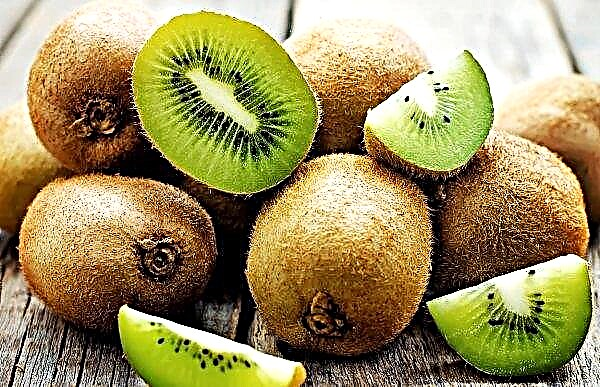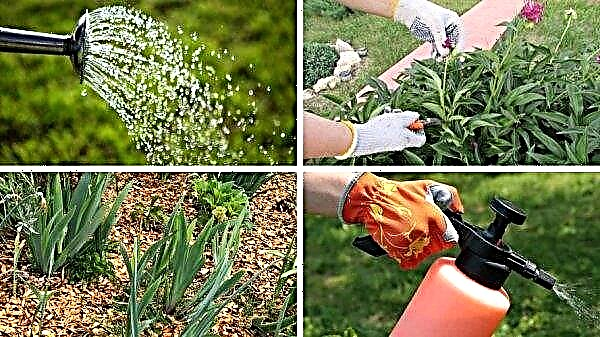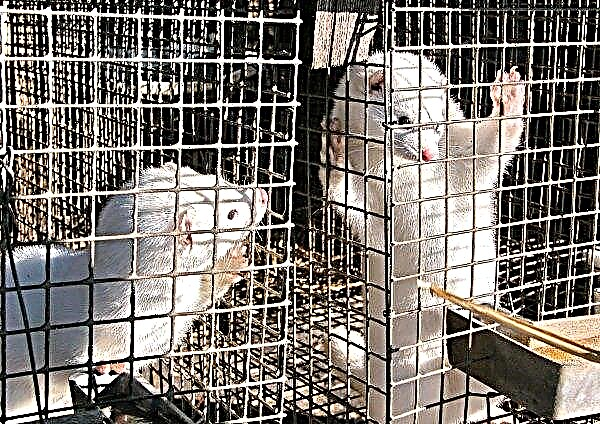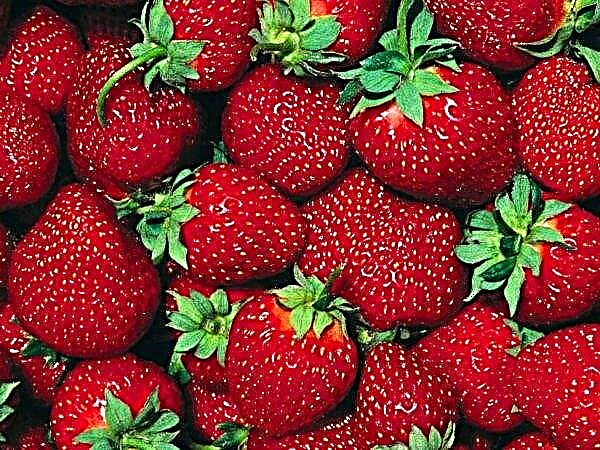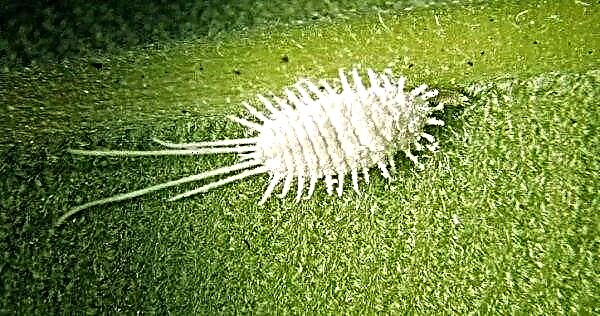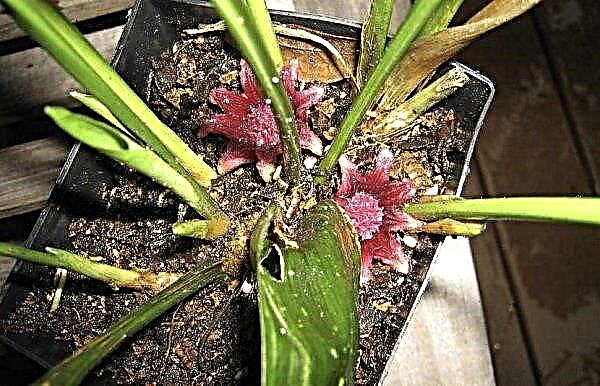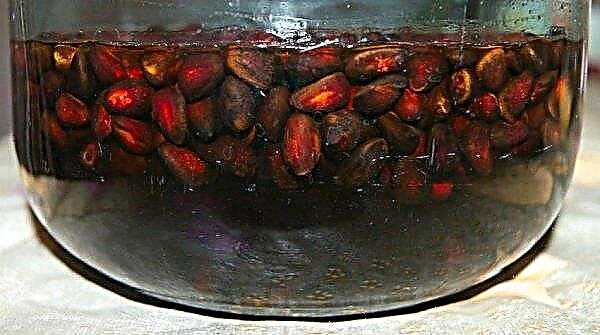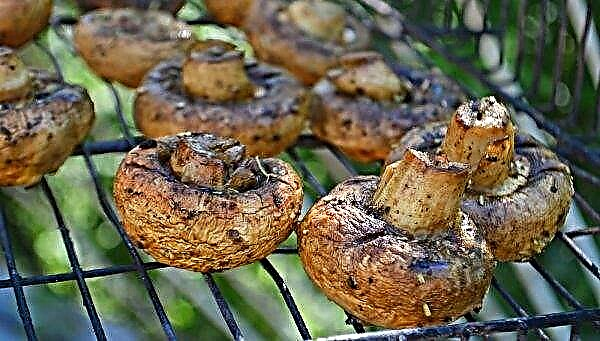Cedar is not the deciduous or flowering plant that can often be found in the gardens of Russian citizens. There are not so many real cedar trees in the country, of course, if we talk about a real tree, and not about substitutional concepts, such as cedar pine. So what exactly is meant by the term “cedar”, how such a tree differs from other conifers and what species exist today - this will be discussed in this article.
What is cedar
Like pine, cedar is a representative of the Pine family, it only belongs to the genus Cedar, class Conifers and is a gymnospermous plant, distributed mainly in the Mediterranean and the Himalayan mountains. This is a powerful and fairly tall tree, with acicular leaves of a bluish or saturated green color.

Monoecious, but heterosexual plant, therefore, both male and female generative organs are found on the same species specimen. The first are single ovoid cones of small size, framed by bunches of needles, and the second are slightly longer and often reach a length of 10 cm with a width of 6 cm. Resinous, triangular seeds formed inside grow up to 12–18 cm. The wood of an adult plant is highly appreciated in construction and industry, which is not surprising, because in the old days whole temples and royal palaces were erected from it, which, according to legend, promised their owners prosperity and prosperity.
Important! On Russian territory, it is easiest to see a real cedar in the Caucasian botanical gardens, although cedar pines are much more common. The well-known "cedars of Russia" in most situations turn out to be varieties of this particular plant: for example, Siberian cedar, Korean cedar or cedar.
Characteristics
Representatives of the genus Cedar are truly gigantic trees, the height of which in the wild grows often reaches 40-60 m. The crown is massive and spreading, the bark is dark gray in color, smooth on young plants and scaly on older ones. Branches can be shortened and elongated, and on the latter there is a spirally arranged needles. To the touch, it is stiff and prickly, with three or four faces, combined in bundles of five needles. Depending on the type of plant, its color can vary from blue or dark green to gray-silver.

Spikelets of a tree are placed one at a time at the ends of short branches. All of them are erect, in the lower part supplemented by bundles of needles. Female specimens reach a length of 5 cm and have numerous, spirally stamens, with two anthers interconnected, covered with cracks. The pollen itself is enclosed in air bags.
Barrel-shaped or oval-elongated plant cones - erect, solitary. They ripen in the 2nd or 3rd year of tree growth, and the distribution of planting material stored in them occurs mainly in autumn or winter. The weight of the seed wings is approximately 10% of the total weight of the seeds. After entering the ground, young plants sprout only after three weeks. Cedar flowering occurs in the autumn.
 1 - needles, 2 - female cone, 3 - male cone, 4 - tree
1 - needles, 2 - female cone, 3 - male cone, 4 - tree
Homeland of cedar
According to archaeological data, cedar trees have been growing on Earth for hundreds of years, therefore the exact history of the origin of the first such plant is not known exactly. Presumably, the place of occurrence of different species is consonant with their name, which means that the Himalayan mountains will be the birthplace of the Himalayan cedar (C. deodara), the Atlas cedar first grew on the rocky territory of northwestern Africa in the Atlas Mountains, the Lebanese began to spread around the world with Lebanon, and Cypriot or short-coniferous cedar people first met on the island of Cyprus.
Important! The term “cedar” in forestry and forestry literature often refers to other coniferous species of wood and lumber, but you need to know that the “white cedar” (thujoid cypress), the “western red cedar” (giant thuja) and Siberian pine have nothing in common with plants of the same genus.
No less interesting is the history of the origin of the name "cedar". According to one of the most common theories, the first Cedar is a European plant that grows during the existence of Ancient Rome in the territory of modern Italy. Having landed on the island of Crete, Roman soldiers saw a tree growing there, very similar to those located next to their houses - cedar pines. Later it became known that they are not completely identical. In Russian history, there is no exact data on the origin of the tree name, but it is known that in Russia they grew on the territory of the eastern part of Novgorod the Great.

Spread
In the natural habitat, cedars grow in the southern and eastern regions of the Mediterranean territory and in the west of the Himalayas. In the south of Crimea, trees “took root” in the territory from Sevastopol to Kara-Dag, that is, where the minimum temperature values do not reach -25 ° C. Lebanese cedar grows in the botanical garden in Odessa, giving self-sowing and withstanding temperature drops to -27 ° C (exactly the same as the Crimean specimens).
Theoretically, cedar can be found in other countries, where all conditions for optimal plant growth and development will be created: loose, permeable soils, with a minimum content of lime, sufficient humidity and the absence of very frosty winters. On dry, southern slopes with a high level of lime in the substrate, the Himalayan cedar often suffers from chlorosis and eventually dies. This applies to Atlas and Lebanese cedars, but they are less prone to this ailment. In the middle belt or in the Ural territory (from 400 m above sea level) cedars can successfully grow even in steep, well-known areas, but only if there is a sufficient amount of fresh soil and high humidity.

What does a tree look like?
An adult tree of any kind of cedar is a powerful plant with dense and massive brown-brown branches, thick at the warp and tapering towards the end. It can not be called small, dwarf or stunted, because even by seedlings it is noticeable how massive their parts are. At a young age, the crown is more conical, but after 5–10 years of cedar growth it becomes flat-peak or ostropyramidal.
In some varieties (for example, Lebanese cedar), the apex almost immediately acquires a conical shape. In addition, a specific role in the growth of plants plays a significant role in describing the appearance of plants: with a limited amount of space and a small area of nutrition, the trees often stretch upwards, and in single plantings they are more spreading, with several peaks.
Did you know? Pine nuts popular today are not seeds of this plant. This product is obtained from cedar pine, while the seeds of this cedar (Himalayan, Lebanese or any other kind) are inedible, and they can not be found in the free market.
The annual branches of the culture have a yellowish color with a reddish tinge and are covered with a trihedral, serrated at the edges of the needles, collected in pieces of 5 pieces each on shortened shoots (there are up to 50 dark green needles on a single branch). Despite its needle-like shape, such sheets can be called soft, especially in young plants. In general, needles up to 14 cm long live 7–10 years, after which they turn yellow and fall. It is noteworthy that at the same time no more than two of the five needles dying in the bunch die.
 Cedar flowering is observed mainly in the spring, but its cones reach their full ripening closer to autumn, next year
Cedar flowering is observed mainly in the spring, but its cones reach their full ripening closer to autumn, next year
Types of Cedars
Real cedar trees are divided into only 4 main types: Atlas, Lebanese, Himalayan and Cypriot, which are also called short-coniferous cedar. The remaining plants are not representatives of this genus and may be similar to them only from afar. In general, all true representatives of the genus have many similar characteristics, but at the same time it is worth knowing by what characteristics they can be distinguished from each other.
Atlas
This kind of cedar is found on the slopes of the Atlas Mountains and in Algeria, and in the most inaccessible regions, at an altitude of 1300–2000 m above sea level. In appearance, these are large trees with a trunk height of 50 m and a diameter of at least 1.5–2 m. Gray-brown branches are covered with blue-green needles, with bundles of needles bundled up to 2.5 cm in length. During fruiting, the plants form cylindrical cones reaching 10 centimeters. The seeds are hidden in them, reaching 10-12 cm and having a wing of up to 15 mm.
The wood of the plant is always resinous, with a strong smell of sandalwood. Both the cones and needles of the Atlas cedar are slightly shorter than those of the Lebanese variety, and they calmly tolerate winter temperature drops to -20 ° C and short drought. Like other types of cedar, the Atlas plant begins to bloom in the fall, which is expressed in the appearance of unique blue-violet flower cones.

Lebanese
This evergreen conifer in favorable growing conditions often reaches 40–50 m in height with a trunk diameter of up to 2.5 m. The crown of young plants has a conical shape, but as it grows it changes to a flattened, wide and umbrella-like version. The color of the bunching needles (30–40 pieces per collection) ranges from green to gray-blue-green and lasts for two years (all the life of the needles).
Fruiting - once every two years, but only after 25-30 years of tree life. Cylindrical, light brown cones, up to 12 cm in length and at least 4-6 cm in width, act as fruits. Inside them, seeds hide about 15–18 mm long and 5–7 mm wide. They are not suitable for food, and in many cases can lead to poisoning.
The bark of the trunk and shoots of Lebanese cedar is dark gray in color and has a scaly structure. The wood is red, strong, light and soft, with a pleasant aroma (smells of pine). This species grows very slowly, but at the same time it is characterized by a rather high level of frost resistance (withstands short-term temperature drops to -30 ° C), tolerates short-term drought and soil composition. Lebanese cedar is one of the symbols of Lebanon, therefore it is displayed on the flag and coat of arms of this country.

Himalayan
The trees of this species are most easily found in the eastern part of Asia, in the northern or western parts of the Himalayas, in the mountains of Pakistan, Afghanistan, Nepal and India. The plant grows well at an altitude of 3600 m above sea level and can form entire forests, combining well with spruce, pine and fir (relevant for taiga coniferous regions). Outwardly, the Himalayan cedar is a massive tree, which often reaches 50 meters in height, with a trunk diameter of 3 m. The crown of adult plants is wide-cone-shaped, with horizontally located branches.
The wood is strong, but at the same time soft and very fragrant, light yellow on the outside and red-brown in the central part of the core. The needles are thin, soft to the touch, light gray-green in color, with a slight bluish tint. In coniferous bunches there are 30–40 needles, each of which has 3-4 faces and reaches a length of about 56 cm. The life span of the needles is 3–6 years.
Did you know? One of the oldest and most popular Himalayan cedars in Russia was considered a plant from Sochi, which since 1978 had the status of a natural monument. It was cut in 2017 at the age of about 190 years.
Cones ripening begins only 1.5 years after the beginning of their formation, but already in the second and third year they crumble (on the shoots they sit on top, in the up direction). The seeds inside are white, about 16-17 mm long, resinous and inedible. Compared to other varieties, cedars of this group tolerate partial shade much better and under suitable growing conditions can reach the age of 1000-3000 years.

Short conifer
Short-coniferous, also known as Cypriot cedar, is a medium-sized tree whose height is limited to 12 m with a trunk diameter of 2 m (only individual specimens reach 30 m in height). In the natural environment of growth, this plant is found only on the territory of the island of Cyprus, mainly in the mountains. Powerful shoots grow horizontally, slightly rushing down, which is why the young pyramidal crown resembles a huge umbrella. Under the spreading broad branches, densely covered with needle needles, a gray-brown shoot bark is visible.
This plant is called short-coniferous because of the short length of the needles, which often do not exceed 5–8 mm (in extreme cases, you can find specimens with needles up to 12 mm in length). Their color is blue-green in the warm season and slightly gray in the cold season. The needles collected in numerous bunches make the plant fluffy.
Short coniferous cedar blooms in early autumn, and a little later, pale brown male cones and reddish female cones appear on it, which, after pollination, ripen only after a year (throw out winged seeds). The maximum length of the cones is 7 cm. Under suitable growing conditions, the life span of the Cypriot cedar will be more than one hundred years, which is only slightly inferior to the values of the other species.

The difference between cedar and other conifers
In addition to cedar pine, there are some other plants that look similar to real cedar. In order not to confuse them with each other, it is worth knowing about the main possible differences between these conifers. For example, pine fruiting is annual, but on cedars, cones ripen no more than once every four years. The needles of an adult pine tree are collected in bunches of 2 pieces, and for a cedar - 5, and in the latter case they are slightly longer. The color of pine needles depends on the place of growth of the tree, but usually has a yellowish or silver hue, while most cedar leaves have a color in rich green tones.
Cedar needles also seem longer in comparison with the needles of spruce, which is always greener, harder and prickly. The needles are arranged both spirally and singly, well attaching to leaf cushions. Every year, spruce trees drop up to 1/7 of all the needles available on them, but replacing it with cedar is smoother and less frequent.
Differences between spruce and cedar tree are also visible in the shape of their crown.: in the first case, it resembles a cone (shoots are slightly lowered down), and in the second it is spread to the sides. The main distinguishing characteristics of the cedar are its relatively large size and not so sharp needles, therefore, with a careful visual examination of both plants, it is easy to determine which species is in front of you.

Useful properties of needles and its use in traditional medicine
- The benefits of various parts of cedar wood in the fight against a variety of ailments are confirmed not only by folk, but also by traditional medicine, because essential oils and coniferous extracts are often included in the composition of drugs to eliminate the problems of the following organs and systems of the human body:
- respiratory system;
- digestive systems;
- kidney and liver;
- genitourinary system;
- organs of the cardiovascular system.
With proper preparation of healing infusions and decoctions, they will effective in the treatment of anemia, hypertension, tuberculosis, atherosclerosis, mastitis, arthritis, gastritis and stomach ulcers. Today, the effectiveness of cedar medicines in the prevention of cardiovascular pathologies is scientifically confirmed, and the resin of the plant is a good antiseptic that inhibits the growth of bacteria that cause diphtheria and staphylococcus.

If necessary, infusions with the addition of gum can also be used as an external agent in the treatment of furunculosis, purulent wounds and abscesses. Of course, essential oils, infusions and decoctions will have different levels of useful properties, therefore, before preparing this or that medicine, it is worth deciding on its most preferred form:
- Tincture on needles and cedar sprouts - An excellent diuretic composition, as well as a good remedy in the treatment of bronchial asthma, tuberculosis, inflammatory processes in the respiratory system, prostatitis and uterine bleeding, not to mention arthritis, rheumatoid pain and gout (alcohol tincture warms up the body perfectly). In addition, such a tincture can be added to the water when taking a bath, which will help relieve fatigue, increase the body's immune forces and improve the emotional state.
- Plant seed essential oil - a nutritious product that promotes the removal of sputum with an unproductive cough and the elimination of unpleasant symptoms of stomach ulcers and other gastrointestinal diseases. Outwardly, it is used in the preparation of compresses and solutions for lotions in the treatment of burn wounds.
- Decoctions of needles often used for bronchitis, pneumonia, tonsillitis, stomatitis, and even a runny nose, by digging into the nostrils.
- Cedar Gum Camphor can be used to eliminate ailments of the nervous system and even schizophrenia, and bathtubs with turpentine will be appropriate in case of the deposition of a large amount of salts in the joints.
Did you know? In ancient times, cedar wood was considered one of the best building materials. It was from it that the sarcophagi of the pharaohs were often made, temples and palaces were erected.
Healing properties
Given the aforementioned ailments, which various infusions and decoctions on the basis of different parts of the cedar tree help to cope with, it is not difficult to guess the specific therapeutic possibilities of the plant.

- The list of which includes such effects on the human body:
- anti-inflammatory;
- diuretic;
- expectorant;
- antibacterial;
- anti-scurvy;
- antimicrobial;
- hemostatic;
- sedative;
- immunomodulatory;
- anti-asthma;
- blood purifying;
- restorative.
In addition, with the regular use of various products prepared using cedar raw materials, there is every chance improve blood composition, increase the elasticity of vascular walls, lower cholesterol in the body, lower blood pressure and reduce excess body weight, while contributing to increased production of juice in the stomach and reduce its acidity. Not only needles, but also cedar wood can release substances that help clean indoor air. This means that even wooden products from the described plant can benefit a person, and not only aesthetic.

Contraindications
There are no significant contraindications to the use of cedar in folk medicine. The undesirable consequences of such treatment are mainly due to individual intolerance to the chemical constituents of the plant and the body’s tendency to allergic reactions to needles. However, you should not uncontrollably take cooked infusions and decoctions in large quantities.
It is advisable to start using formulations with small doses, for example, ½ teaspoon of tincture or 2-3 tbsp. spoons of infusion. The consumption of cedar pine nuts requires the same responsible approach, even if they are mistaken for the fruits of real cedar.

Cedar is a truly interesting and magnificent representative of the plant world, which, with some knowledge, may well become a valuable storehouse of healing properties for many people, and the ability to distinguish false plants from real ones will only help in this. In addition, detailed information about the external features and requirements of one kind or another to the growing conditions will be very relevant if you want to grow a tree in your garden.

